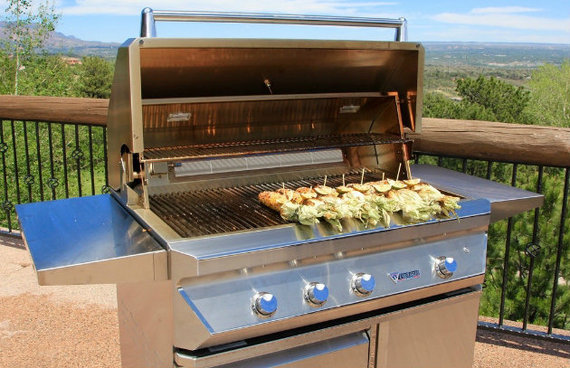There are many ways you could categorize the world's dozens, perhaps hundreds, of different grills. You could group them by fuel, for example: charcoal grills, wood-burning grills, gas grills. You could organize them by region of origin -- the grills of South America, for example, or Southeast Asia. But the most useful way, from a griller's point of view, is by the configuration of the fire and where to place the food for cooking. This is what determines at what temperature and how quickly the food will grill. Understanding and controlling these variables goes a long way toward determining your success as a grill master.
Open Grill
The simplest of all grills: a metal or stone box with the burning charcoal, wood, or propane at the bottom and the food positioned directly over the fire. The grill grate is optional.
Includes: North American and European table grills, South American parrillas, the Italian fogolar, the Balkan mangal, Indonesian saté grill, Asian bucket grills, the Australian flattop grill, and so on.
Used for: High-heat direct grilling
Foods Best Suited: Small, tender, quick-cooking foods like satés, kebabs, steaks, chops, fish fillets, vegetables, and so on
Covered Grill
Add to an open grill a tall lid you can raise and lower and you get a covered grill. This may sound like a simple innovation, and yet the covered grill enables you to add two additional important methods of live-fire cooking to your repertory: indirect grilling and smoking.
Includes: The kettle grill, gas grill, and 55-gallon steel-drum grill
Used for: Direct grilling larger or thicker foods. Indirect grilling and smoking (the latter done primarily on charcoal-burning grills)
Foods Best Suited: Thick steaks--both beef and tuna--as well as double-thick pork and veal chops. Larger or fattier cuts of meats, like whole chicken and duck, pork shoulder, and baby back ribs.
Vessel Grill
A name I coined to describe deep, thick-walled, ceramic grills that rely on the radiant heat of the side walls, as well as the direct heat from the coals, to cook the food. Sometimes the food is cooked directly on the walls (breads) or on a vertical spit positioned inside the firebox instead of on a grill grate.
Includes: India's tandoor, Iran's tanoor, and closer to home, kamado-style cookers, like the Kamodo Kamado and Big Green Egg
Used for: High-heat roasting. With the kamado cooker, roasting, grilling, and smoking.
Foods Best Suited: Flatbreads, like Indian naan, which are cooked right on the walls of the tandoor. Kebabs, chicken, fish steaks, small legs of goat and lamb, peppers, paneer cheese--all cooked on a vertical spit.
For details about the three other major types of grills, visit BarbecueBible.com.
Adapted from Planet Barbecue!
SIGN UP for Steven Raichlen's UP IN SMOKE newsletter to learn more about barbecue!
--
Steven Raichlen is the author of the Barbecue! Bible cookbook series and the host of Project Smoke on public television. His web site is BarbecueBible.com.
